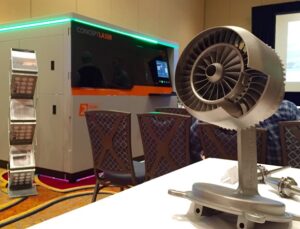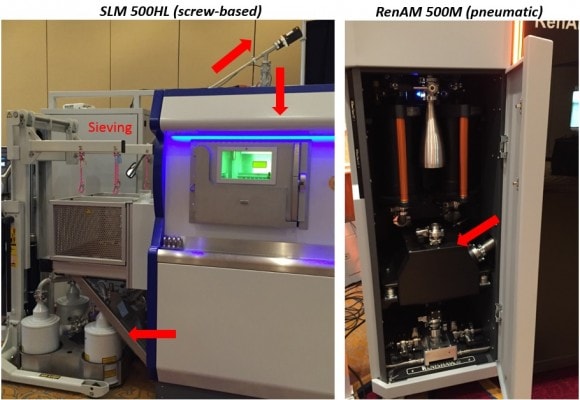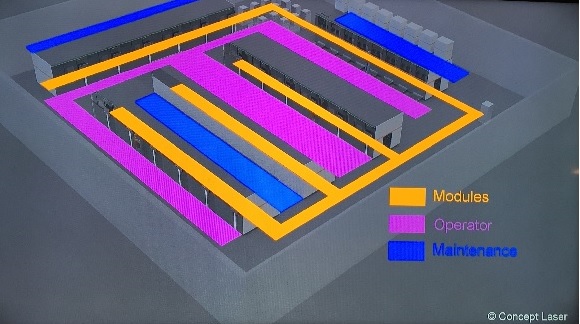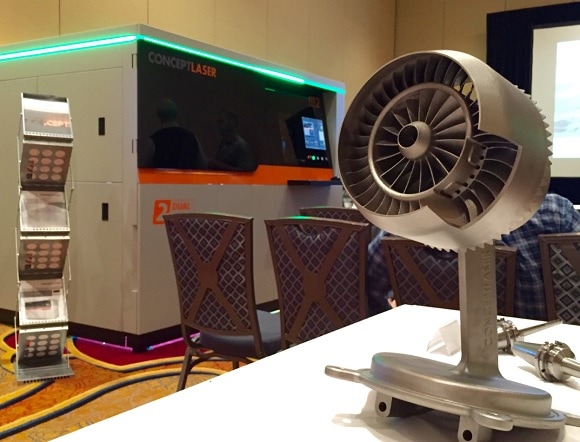
One of the more difficult things about being at the Additive Manufacturing Users Group (AMUG) is dealing with the fact that there is more to do than you can hope to accomplish in four and a half days. So I decided to focus on two themes: laser-based metal additive manufacturing (AM); and design & simulation for AM. In this post, I focus on the former and try to distill the trends I noticed across the laser-based metal AM system manufacturers that were present at the conference: Concept Laser, SLM, Renishaw, EOS and 3D Systems (listed here in the decreasing order of the time I spent at each supplier’s booth). While it is interesting to study how 5 different suppliers interpret the same technology and develop machines around it, it is not my objective to compare them here, but to extract common trends that most suppliers seem to be working on to push their machines to the next level. For the purposes of this post, I have picked the top-of-the-line machine that each supplier offers as an indication of the technology’s capabilities: they span a range of price points, so once again this is not meant to be a comparison.
As a point of observation, the 5 key trends I noticed turned out to be all really aspects of taking the technology from short run builds towards continuous production. This was not my intent, so I believe it is an accurate indication of what suppliers are prioritizing at this stage of the technology’s growth and see as providing key levers for differentiation.
1. Quality Monitoring
Most customers of AM machines that wish to use it for functional part production bemoan the lack of controls during manufacturing that allow them to assess the quality of a part and screen for excursionary behavior without requiring expensive post-processing inspection. Third party companies like Sigma Labs and Stratonics have developed platform-independent solutions that can be integrated with most metal AM systems. Metal AM suppliers themselves have developed a range of in-situ monitors that were discussed in a few presentations during AMUG, and they generally fall into the following categories:
- Input Monitors:
- Laser: Sensors monitor laser powder as well as temperature across the different critical components in the system
- Oxygen Level: Sensors in the build chamber as well as in sieving stations track O2 levels to ensure the flushing of air with inert Argon or Nitrogen has been effective and that there are no leaks in the system
- Output Monitors:
- Live video: simple but useful, this allows users to get a live video stream of the top layer as it is being built and can help detection of recoater blade damage and part interaction
- Meltpool: Concept Laser showed how its Meltpool monitoring system can be used to develop 2D and 3D plots that can be superimposed with the 3D CAD file to identify problematic areas – the video is also on YouTube and embedded below. SLM and EOS offer similar meltpool monitoring solutions.
- Coater consistency: Concept Laser also described a monitor that captures before and after pictures to assess the consistency of the coater thickness across the build area – and this information is fed forward to adjust subsequent coater thicknesses in an intelligent manner.
https://youtu.be/19N2UqO6dEY?t=10s
Quality monitoring systems are still in their infancy with regard to what is done with the information generated, either in terms of feed forward (active) process control or even having high confidence in using the data to validate part quality. A combination of supplier development and academic and industry R&D is ongoing to get us to the next level.
2. Powder Handling
In a previous post, I touched upon the fire and explosion risks posed by metal powder handling. To lower the bar for an operator to gain access to a metal AM machine, one of the considerations is operator safety and the associated training they would need. Suppliers are constantly trying to improve the methods by which they can minimize powder handling. For a mechanical engineer, it is intriguing to see how reactive metal powders can be moved around in inert atmospheres using different strategies. The SLM 500HL uses a screw system to move the powder around in narrow tubes that stick out of the machine and direct the material to a sieving station after which they are returned to the feed area. The Renishaw RenAM 500M on the other hand uses a pneumatically driven recirculation system powered by Argon gas that is well integrated into the machine frame. Concept Laser also offers automated powder handling on the XLine 2000R, while EOS and 3DSystems do not offer this at the moment. Figure 2 below does not do justice to the level of complexity and thought that needs to go into this.

One of the limitations of automating powder handling is the ability to change materials, which is very hard to impossible to do with high enough confidence with these systems. As a result, their use is limited to cases where one machine can be dedicated to one material and efficiency gains of powder handling can be fully realized. The jury is still out on the long term performance of these systems, and I suspect this is one area that will continue to see improvements and refinements in subsequent model releases.
3. Multi-Laser Processing
In the quest for productivity improvement, one of the biggest gains comes from increasing the number and power of available lasers for manufacturing. In my previous experience with laser based systems (albeit not for this application), an additional laser can increase overall machine throughput by 50-80% (it does not double due to steps like the recoater blade movement that does not scale with the number of lasers).
The suppliers I visited at AMUG have very different approaches to this: SLM provides the widest range of customizable options for laser selection with their 500HL, which can accept either 2 or 4 lasers with power selection choices of 400W or 1000W (the 4 laser option was on display, YouTube video from the same machine in action is below) – the lasers of different powers can also be combined to have two 400W and two 1000W lasers. Concept Laser’s XLine 2000R allows for either 1 or 2 1000W lasers and their smaller, M2 machine that was showcased at AMUG has options for 1 or 2 lasers, with power selection of 200W or 400W. EOS, Renishaw and 3D Systems presently offer only single laser solutions: the EOS M 400 has one 1000W laser, Renishaw’s RenAM 500M has one 500W laser and the ProX DMP 320 from 3D Systems has one 500W laser.
There are a few considerations to be aware of when assessing a multi-laser machine: Each laser drives an increase in machine capital cost. But there is another point of note to remember when using multi-laser systems for manufacturing that centers around matching process outputs from different lasers: laser-to-laser variation can be a dominant source of overall process variation and can drive a need to calibrate, maintain and control both lasers as if they were independent machine systems. Additionally, development of a process on one particular laser power (100W, 400W, 500W, 1000W) may not scale easily to another and is something to remember when developing a long term strategy for metal AM that involves different kinds of machines, even if from the same supplier.
4. Software Integration
Renishaw spent a significant amount of time talking about their easy-to-use QuantAM software which is designed to integrate Renishaw process parameters and part processing information more tightly and allow for seamless process parameter development without needing third part software like Magics. Additive Industries announced in their presentation at AMUG that they had just signed an agreement with 3DSIM to integrate their support design software solution into their MetalFab1 machine. Software integration is likely to be an increasing trend especially around the following areas:
- Improving support design methods and reducing its empirical nature and reducing the material, build time and support removal costs associated with them as well as eliminating the need for iterative builds
- Increasing process options available to the user (for example for the outer skin vs the inner core, or for thick vs thin walls)
- Simplifying the development of optimized process parameters for the user working on new materials
- Integrating design and process optimization to increase effective part performance
In a future blog post, I will look specifically at the many design and simulation tools available around AM and how they are connected today even if not well-synergized.
5. Modular System Architectures
In a list of mostly evolutionary changes, this is the one area that struck me as being a step-change in how this technology will make an impact, even if it will be felt only by larger scale manufacturers. Concept Laser and Additive Industries are two companies that delivered presentations discussing how they were approaching the challenge of revolutionizing the technology for true production and minimizing the need for human touch. Common to both is the notion of modularity, allowing for stacking of printing, powder removal, heat treating and other stations. While Additive Industries are developing a flow resembling a series production line, Concept Laser have taken the more radical approach of having autonomous vehicles delivering the powder bed to the different stations, with travel channels for the vehicles, for the operator and for maintenance access (Figure 3). Both companies expect to have solutions out by the end of this year.

Concluding Thoughts
It is an interesting time to be a manufacturer of laser-based metal 3D printers, and an even more interesting time to be a consumer of this technology. The laser-material interaction fundamentals of the process are now fairly well-established. Competitors abound both in existing and emerging markets with machines that share many of the same capabilities. Alternative technologies (E-Beam melting, deposition and jetting) are making strides and may start to play in some applications currently dominated by laser-based technologies. A post early-adopter chasm may be around the corner. This will continuously drive the intense need to innovate and differentiate, and possibly also lead to a merger or two. And while most of the news coming out of conferences is justifiably centered around new process technologies (as was the case with Carbon’s CLIP and XJET’s metal nanoparticle jetting at AMUG this year), I think there is an interesting story developing in laser-based powder bed fusion and can’t wait to see what AMUG 2017 looks like!



















